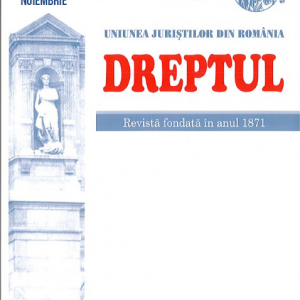-
 The authors examine the issue of the former immovable properties, exclusively “state-owned” (during 1948-1991), which later, after 1991, became, as appropriate, public or private property, either of the State or of the administrative-territorial units. Whereas the status of such property is not always expressly clarified by legal rules (in the sense that after 1991 they became public or private property either of the state or of the territorial administrative units), in end of the study the authors embrace certain legal criteria for performing the said placement, thus trying to find a solution to the problem which is the subject of this study.
The authors examine the issue of the former immovable properties, exclusively “state-owned” (during 1948-1991), which later, after 1991, became, as appropriate, public or private property, either of the State or of the administrative-territorial units. Whereas the status of such property is not always expressly clarified by legal rules (in the sense that after 1991 they became public or private property either of the state or of the territorial administrative units), in end of the study the authors embrace certain legal criteria for performing the said placement, thus trying to find a solution to the problem which is the subject of this study. -
 This article seeks to clarify whether the scope of the revision cases also includes the one based on a case dismissal solution given by the prosecutor and that was deemed by a part of the legal practice as documentary evidence for the purposes of Section 5 of the Art. 322 of the Code of Civil Procedure. The author shows that the analysis of the meaning of “documentary evidence” has determined that the prosecutor’s acts lack this character, as the case dismissal solution is not decisive for the fate of the trial and has no probative value in itself. Examination of these admissibility aspects, and exclusion of the prosecutor’s case dismissal resolution / ordinance from the documentary evidence category are reasons for supporting the conclusion that this solution adopted by the prosecutor shall not be imposed upon the civil court and can not substantiate a revision which is based on the provisions of Section 5 of the Article 322 of the Code of Civil Procedure.
This article seeks to clarify whether the scope of the revision cases also includes the one based on a case dismissal solution given by the prosecutor and that was deemed by a part of the legal practice as documentary evidence for the purposes of Section 5 of the Art. 322 of the Code of Civil Procedure. The author shows that the analysis of the meaning of “documentary evidence” has determined that the prosecutor’s acts lack this character, as the case dismissal solution is not decisive for the fate of the trial and has no probative value in itself. Examination of these admissibility aspects, and exclusion of the prosecutor’s case dismissal resolution / ordinance from the documentary evidence category are reasons for supporting the conclusion that this solution adopted by the prosecutor shall not be imposed upon the civil court and can not substantiate a revision which is based on the provisions of Section 5 of the Article 322 of the Code of Civil Procedure. -
 The new Romanian Criminal Code’s lawmaker took most of the regulations from the Criminal Code in force, the so-called constants of criminal law, but also introduced new ones, unknown to our law, some of which being required by the current socio-economic conditions and others being introduced out of the lawmaker’s desire to bring something new to the criminal law in force or simply to take them from other foreign laws, although criminal law science did not call for this. In this study, the authors make an inventory of these innovations, while attempting to analyze thereof and show the unfittingness of their introduction or acquisition from other foreign laws.
The new Romanian Criminal Code’s lawmaker took most of the regulations from the Criminal Code in force, the so-called constants of criminal law, but also introduced new ones, unknown to our law, some of which being required by the current socio-economic conditions and others being introduced out of the lawmaker’s desire to bring something new to the criminal law in force or simply to take them from other foreign laws, although criminal law science did not call for this. In this study, the authors make an inventory of these innovations, while attempting to analyze thereof and show the unfittingness of their introduction or acquisition from other foreign laws.
